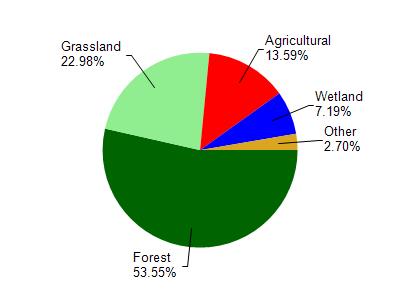Richland
Yes
Yes
No
Fish and Aquatic Life
Overview
Hoover Hollow Creek flows for 2.7 miles from southeast Crawford County into southwest Richland County before reaching Knapp Creek. This stream has a steep gradient of approximately 100 feet per mile. Hoover Hollow Creek is a Class I trout stream. A fisheries and habitat survey of Hoover Hollow Creek should be conducted to update the last biological survey in 1969. Access is possible from four road crossings.
Date 2002
Author Cynthia Koperski
Overview
Hoover Hollow Creek flows for 2.7 miles from southeast Crawford County into southwest Richland County before reaching Knapp Creek. This stream has a steep gradient of approximately 100 feet per mile. Hoover Hollow Creek is a Class I trout stream for its first 1.5 miles in Richland County and Class II for 1.2 miles in Crawford County.
A fisheries and habitat survey of Hoover Hollow Creek should be conducted to update the last biological survey in 1969. Access is possible from four road crossings.
Date 2001
Author Aquatic Biologist
Historical Description
This small spring-fed stream is tribulary to Knapp Creek. Although it has a lower than
average gradient, about 2.7 miles of the stream support trout (WDNR, 1980). About 1.5
miles are Class I trout waters and are designated exceptional resource waters (ERW).
The Class II portion of the strearrl could be Class I trout waters with proper management
and controls (Eagan, 1985~). Runoff irom barnyards and cropland, and bank erosion
are thought to cause water quality and habitat problems, although no water quality or
biological data exists. There was one documented fishkill attributable to manure
handling (Kerr, 1991) .
Date 1994
Author Surface Water Inventory Of Wisconsin
General Condition
Hoover Hollow Creek (WBIC 1207000) from its mouth to the Richland-Crawford county line was assessed during the 2018 listing cycle; new biological (fish Index of Biotic Integrity (IBI) scores) sample data were clearly below the 2018 WisCALM listing thresholds for the Fish and Aquatic Life use. This water was meeting this designated use and was not considered impaired.
Date 2017
Author Ashley Beranek
Condition
Wisconsin has over 84,000 miles of streams, 15,000 lakes and milllions of acres of wetlands. Assessing the condition of this vast amount of water is challenging. The state's water monitoring program uses a media-based, cross-program approach to analyze water condition. An updated monitoring strategy (2015-2020) is now available. Compliance with Clean Water Act fishable, swimmable standards are located in the Executive Summary of Water Condition in 2018. See also the 'monitoring and projects' tab.
Reports
Management Goals
Wisconsin's Water Quality Standards provide qualitative and quantitative goals for waters that are protective of Fishable, Swimmable conditions [Learn more]. Waters that do not meet water quality standards are considered impaired and restoration actions are planned and carried out until the water is once again fishable and swimmable
Management goals can include creation or implementation of a Total Maximum Daily Load analysis, a Nine Key Element Plan, or other restoration work, education and outreach and more. If specific recommendations exist for this water, they will be displayed below online.
Monitoring
Monitoring the condition of a river, stream, or lake includes gathering physical, chemical, biological, and habitat data. Comprehensive studies often gather all these parameters in great detail, while lighter assessment events will involve sampling physical, chemical and biological data such as macroinvertebrates. Aquatic macroinvertebrates and fish communities integrate watershed or catchment condition, providing great insight into overall ecosystem health. Chemical and habitat parameters tell researchers more about human induced problems including contaminated runoff, point source dischargers, or habitat issues that foster or limit the potential of aquatic communities to thrive in a given area. Wisconsin's Water Monitoring Strategy was recenty updated.
Grants and Management Projects
| Project Name (Click for Details) | Year Started |
|---|
|
|
Monitoring Projects
| WBIC | Official Waterbody Name | Station ID | Station Name | Earliest Fieldwork Date | Latest Fieldwork Date | View Station | View Data |
|---|
| 1207000 | Hoover Hollow Creek | 10029884 | Hoover Hollow Station 1 along Hwy 60 | | | Map | Data |
| 1207000 | Hoover Hollow Creek | 10029885 | Hoover Hollow Station 2 Along Hoover Hollow Rd | | | Map | Data |
| 1207000 | Hoover Hollow Creek | 10051339 | Hoover Hollow ~3000ft US HWY 60 off private dr | | | Map | Data |
| 1207000 | Hoover Hollow Creek | 10022306 | Hoover Hollow (Cr. 36-16) St. 1 - Fence Above Hwy 60 Bridge (State Lands) | 1/1/2015 | 1/1/2015 | Map | Data |
|

Watershed Characteristics
Hoover Hollow Creek is located in the Knapp Creek watershed which is 158.64 mi². Land use in the watershed is primarily forest (53.60%), grassland (23%) and a mix of agricultural (13.60%) and other uses (9.90%). This watershed has 395.31 stream miles, 126.86 lake acres and 6,498.05 wetland acres.
Nonpoint Source Characteristics
This watershed is ranked Medium for runoff impacts on streams, Not Ranked for runoff impacts on lakes and High for runoff impacts on groundwater and therefore has an overall rank of High. This value can be used in ranking the watershed or individual waterbodies for grant funding under state and county programs.This water is ranked High Stream for individual Rivers based on runoff problems and the likelihood of success from project implementation.